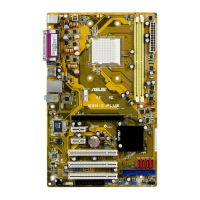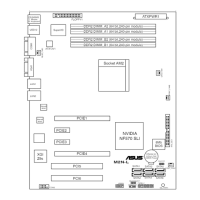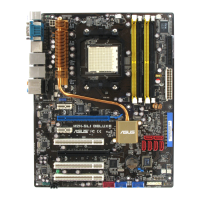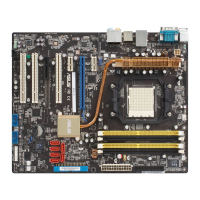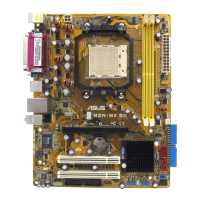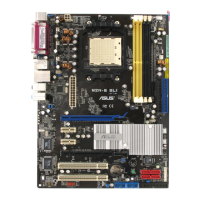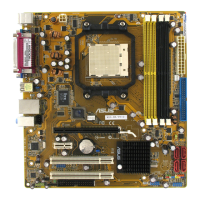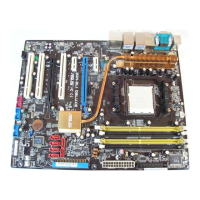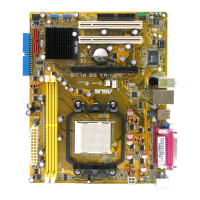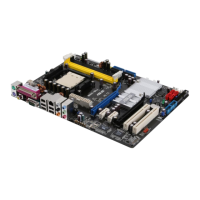Do you have a question about the Asus M2N-MX and is the answer not in the manual?
Introduces the motherboard and lists included package items for verification.
Highlights the main technologies and product specifications of the motherboard.
Details unique ASUS features like CrashFree BIOS 2 and Q-Fan for enhanced functionality.
Essential safety precautions to follow before installing or modifying hardware.
Visual guide to the motherboard's layout, slots, and connectors.
Step-by-step guide for correctly installing the CPU into the socket.
Instructions for properly mounting the CPU heatsink and fan assembly.
Guide to installing DDR2 memory modules and recommended configurations.
Explains how to install expansion cards in PCI and PCI Express slots.
Details the function of jumpers and identifies motherboard connectors.
Covers utilities for updating, saving, and managing the system BIOS.
Explains the BIOS setup menu structure, navigation keys, and screen elements.
Adjusting basic system settings like date, time, and storage device configurations.
Detailed configuration options for CPU, Chipset, and various system devices.
Options for controlling system power states, ACPI, and APM features.
Settings to define the sequence of devices for system boot-up.
Procedures for setting supervisor and user passwords for BIOS access.
Guides on saving, discarding changes, or loading default BIOS settings.
Notes on installing OS and service packs for optimal hardware compatibility.
Lists drivers, applications, and utilities available on the motherboard support CD.
Instructions for installing key drivers like Chipset, Audio, and AMD utilities.
Guides on installing system management tools like PC Probe and Adobe Reader.
Steps to create a bootable floppy disk for NVIDIA RAID driver installation.
Introduces the motherboard and lists included package items for verification.
Highlights the main technologies and product specifications of the motherboard.
Details unique ASUS features like CrashFree BIOS 2 and Q-Fan for enhanced functionality.
Essential safety precautions to follow before installing or modifying hardware.
Visual guide to the motherboard's layout, slots, and connectors.
Step-by-step guide for correctly installing the CPU into the socket.
Instructions for properly mounting the CPU heatsink and fan assembly.
Guide to installing DDR2 memory modules and recommended configurations.
Explains how to install expansion cards in PCI and PCI Express slots.
Details the function of jumpers and identifies motherboard connectors.
Covers utilities for updating, saving, and managing the system BIOS.
Explains the BIOS setup menu structure, navigation keys, and screen elements.
Adjusting basic system settings like date, time, and storage device configurations.
Detailed configuration options for CPU, Chipset, and various system devices.
Options for controlling system power states, ACPI, and APM features.
Settings to define the sequence of devices for system boot-up.
Procedures for setting supervisor and user passwords for BIOS access.
Guides on saving, discarding changes, or loading default BIOS settings.
Notes on installing OS and service packs for optimal hardware compatibility.
Lists drivers, applications, and utilities available on the motherboard support CD.
Instructions for installing key drivers like Chipset, Audio, and AMD utilities.
Guides on installing system management tools like PC Probe and Adobe Reader.
Steps to create a bootable floppy disk for NVIDIA RAID driver installation.
| ECC | Yes |
|---|---|
| Number of memory slots | 4 |
| Maximum internal memory | 4 GB |
| Processor socket | Socket AM2 |
| Processor manufacturer | AMD |
| Maximum number of SMP processors | 1 |
| USB 2.0 connectors | 3 |
| USB 2.0 ports quantity | USB 2.0 ports have a data transmission speed of 480 Mbps, and are backwards compatible with USB 1.1 ports. You can connect all kinds of peripheral devices to them. |
| Audio chip | ADI AD1986A |
| Power source type | ATX |
| Audio output channels | 5.1 channels |
| Motherboard form factor | micro ATX |
| Bundled software | ASUS PC Probe II ASUS LiveUpdate AMD Cool'n'Quiet |
| Graphics card | GeForce 6100 |
| Special features | ASUS Q-Fan ASUS My Logo 2 ASUS CrashFreeBIOS2 ASUS EZ Flash 2 |
| Manageability features | WfM 2.0, DMI 2.0, WOL PME, WOR, PXE |
| Controller interface type | NVIDIA MCP61P |
| Networking features | Gigabit Ethernet |
| BIOS memory size | 32 Mbit |
| RAID levels | 0, 1, 0+1 |
| Depth | 222 mm |
|---|---|
| Width | 245 mm |
